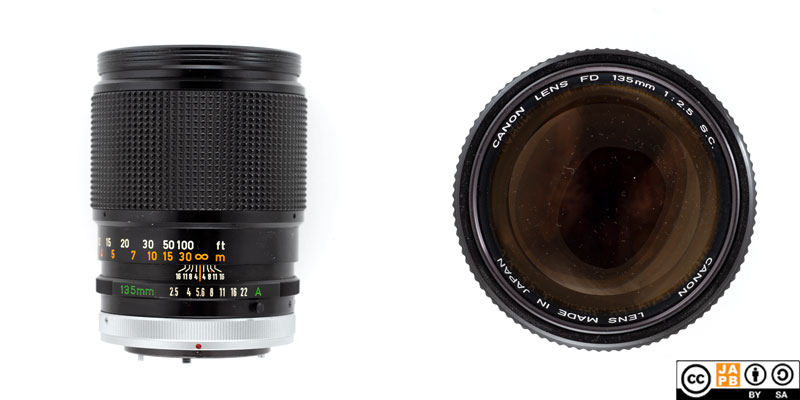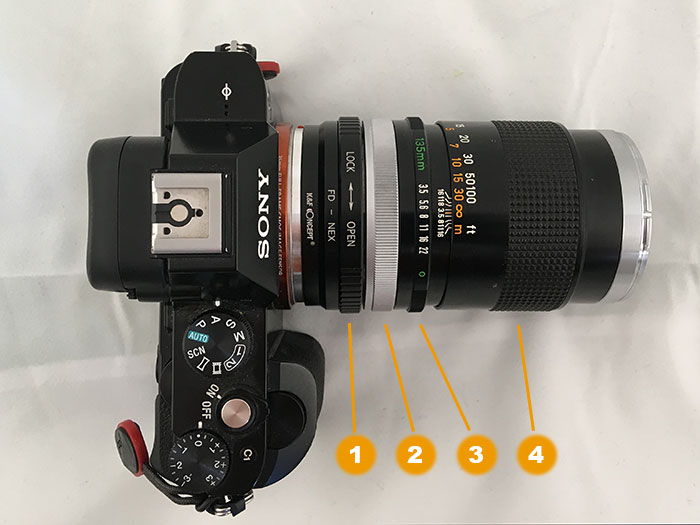Pekka Buttler, 11/2022

Specifications
The table below summarises the lens’ key specifications (measurements based on pictured sample):
| Brand: | Canon | Lens name | FD 135 mm 1:2.5 S.C. |
| Focal length(s) 1 | 135 mm | Angle-of-view 2 | 18° |
| Maximum Aperture | f/2.5 | In Production | 1973–1979 |
| Lens mount | Canon FD | Subfamily (if applicable) | FD |
| Length 3 | 93,1 mm | Diameter 4 | 69,8 mm |
| Filter ring diameter | 58 mm | Weight | 636 grams |
| Lens element count | 6 | Lens group count | 5 |
| Aperture blades (S/R/C) 5 | 8 S | Focus throw | 200 ° |
| Minimum focusing distance | ≈140 cms | Maximum magnification | 1:8.6 |
| Has manual aperture ring | YES | Has Manual focus ring | YES |
| Aperture mechanism type | Automatic | Aperture click stops 6 | 2.5•4•5.6•8•11•16•22 |
Further notes:
• This is by no means a huge lens (not compared to some bright 135’s), but it is significantly larger that Canon’s (or other manufacturers’) 135/3.5’s.
• The lens features a built-in, extendable lens hood.

History of Canon FD lenses
Canon is undoubtedly one of the great names in 35 mm SLR photography. Ever since the 1959 introduction of the Canonflex – Canon’s first interchangeable lens SLR – Canon has constantly focused on being at the forefront of Camera innovation. Often this has necessitated taking stock and redesigning both cameras, lenses and lens mounts. Unlike its arch-rival Nikon, Canon has not tried to integrate all novel features in the same lens mount, but has instead repeatedly launched new, modified mounts to facilitate new features, while still often (but not always) managing to maintain a decent degree of backwards compatibility.
In short (a longer version is here), the development of Canon SLR mounts can be traced as follows:
• 1959–1963: R-mount 7. Canon’s first SLR lens mount. Breech lock-type mount with aperture automation (camera is able to stop down lens for taking the shot.
• 1964–1969: FL-mount. Breech-lock type mount, physically similar mount as Canon R-mount, but camera-to-lens communication linkages somewhat different. Cannot communicate selected aperture to body (stop-down-metering only).
• 1970–1978: FD-mount. Breech-lock mount. FD lenses compatible with FL-cameras and vice versa. Manual focus lenses that communicate aperture information to camera, hence opening the door for automatic exposure (both shutter priority and aperture priority possible)
• 1979–1986: new FD-mount (a.k.a. FDn). Bayonet mount, backwards compatible with FL and FD mounts. Otherwise, as FD mount.
• 1987–today: EF-mount. Electronically controlled autofocus lenses that use an internal focusing motor. Compatible with previous mount lenses only using an adapter with optics.
The era of the Canon FD mount can be characterised by a gradual shift towards the ever-increasing use of plastics and lighter materials (see some more in the JAPB article on the Canon FL, FD and FDn mounts). In the chronology of this gradual shift:
• ‘Chrome nose’ FD lenses (1971–1973) are solid metal (often brass) and glass.
• Black nose FD lenses (1973–1979) are also metal and glass, but especially later, Mk II and III variants have shifted to using less metals and lighter metals.
• FDn lenses (1979–1987) typically make extensive use of plastics.
Another noteworthy point is related to the S.C. and S.S.C. acronyms found on some FD lens’ name rings: S.C. stands for “spectra coating”, while S.S.C. stands for “super spectra coating”. Both are proprietary marketing names for Canon’s optical coating technology. In theory S.S.C. is always a superior form of coating, but that does not mean that one should always try to get an S.S.C. lens, because:
• S.C. and S.S.C. are first and foremost marketing terms, that were not used on early Canon FD lenses, nor on most FDn lenses. Hence, a FDn lens is certain to have at least the level of coating of its direct (FD) predecessor, even though the S.S.(C.) marking is missing from the lens.
• Coating technology developed a lot during the 70s and 80s. A late S.C. coating is liable to be better optimised than an early S.S.C. coating.
Related versions
Canon has a long history of manufacturing bright (brighter that f/3.5) 135 lenses. The 60-year genealogy of these lenses can be summarized (based on data from the Canon camera museum) as:
• S 135 mm f/2.5 (1958–1960), 6 elements in 4 groups, 58 mm filter, 500 grams
• R 135 mm f/2.5 (1960–1965), 6 elements in 4 groups, 58 mm filter, 630 grams
• FL 135 mm f/2.5 (1965–1971), 6 elements in 4 groups, 58 mm filter, 645 grams
• FD 135 mm f/2.5 (1971–1973), 6 elements in 5 groups, 58 mm filter, 670 grams
• FD 135 mm f/2.5 S.C. (1973–1979), 6 elements in 5 groups, 58 mm filter, 630 grams [this lens]
• FDn 135 mm f/2.8 (1979–1987), 6 elements in 5 groups, 52 mm filter, 395 grams
• FDn 135 mm f/2 (1980–≈1990), 6 elements in 5 groups, 72 mm filter, 670 grams
• EF 135 mm f/2.8 Soft Focus (1987–?), 7 elements in 6 groups, 52 mm filter, 390 grams
• EF 135 mm f/2 L (1996–today?), 10 elements in 8 groups, 72 mm filter, 750 grams
Adapting
This lens cannot be used natively on any current SLR or dSLRs. To use it in its native environment, you will need a Canon FD or FL-mount film body.
Thanks to being a fully manual lens (manual aperture, manual focus), the lens can be adapted to all mirrorless cameras using a suitable adapter. However, for the adapter to allow the lens to stop down, you will need an adapter that can be set to engage the FD lens’ aperture control lever. Personally, this is my biggest gripe with the FD-mounts as this leads to what I refer to as the four-ring problem:

[1] Activation ring for aperture control
[2] Locking ring for breech-lock mount
[3] Aperture ring
[4] Focus ring
Note, that especially the first three rings are very close together.
Moreover, a large range of special adapters (helicoid adapters, tilt/shift adapters, speed boosters) for using Canon FD lenses on most mirrorless systems are available.
Using Canon FD lenses on dSLRs is a possibility, but is not problem free. Thanks to the relatively short flange focal distance of the Canon FD mount (at 42,0 mm, clearly shorter than that of any full-frame dSLR mount), any adapter will necessitate some optics to achieve infinity focus.
Footnotes
- Focal length is (unless stated otherwise) given in absolute terms, and not in Full-frame equivalent. For an understanding of whether the lens is wide/tele, see ‘Angle-of-view’. ↩︎
- Picture angle is given in degrees and concerns the diagonal picture angle. Rule of thumb:
> 90 ° ==> Ultra-wide-angle
70–90 ° ==> Wide-angle
50–70 ° ==> Moderate wide-angle
40–50 ° ==> ‘Standard’ or ‘normal’ lens
20–40 ° ==> Short tele lens
10-20 ° ==> Tele lens
5-10 ° ==> Long tele lens
< 5 ° ==> Ultra-tele lens ↩︎ - Length is given from the mount flange to the front of lens at infinity. ↩︎
- Diameter excludes protrusions such as rabbit ears or stop-down levers. ↩︎
- S=straight; R=rounded; C=(almost)circular at all apertures. ↩︎
- Numbers equal aperture values on aperture ring; • intermediate click; – no intermediate click. ↩︎
- The Canon-R mount should possibly be renamed to (or referred to) as the Canonflex mount to avoid confusion with the modern mirrorless mount that is sometimes also referred to as the Canon R mount. ↩︎